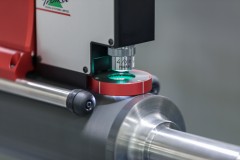The need for measurement: Apex takes anilox accuracy to the next level
Flexo printers around the world agree that productivity is key to their business success. To improve productivity, they need their printing process to be consistent and predictable. This is no easy task, given the amount of variables surrounding flexo technology. Apex’ anilox rolls take at least one important variable out of the complex equation. By adding Troika AniCAM microscopes to its worldwide measurement and control system, Apex even furthers the accuracy of every anilox it manufactures and supplies.
To qualify the above statement we need to be clear on what “ Productivity “ is within the Flexo industry:
Some customers refer to productivity as press efficiency, uptime, press utilization or productivity and in turn, each can be measured in different formats. To be clear and precise Apex refer to “Productivity” as a percentage of time that a press is running saleable printed product at the expected print speed. With the industry aiming for a “Productivity” target of 70% – many flexo printers have to admit to an average of only 35% in reality. Most of their precious time is being spent as set up time, wash up time and downtime. This can only be improved upon by gaining better control of the process and its parameters.
Doing so will enable press operators to produce today in the same way they did yesterday with much less need for compensation adjustments.
Flexo and its variables
The number of variables within the current flexo printing process is excessive: with old and new presses often running side by side combined with the wide variety of plate types, tapes, substrates, inks and anilox that are available in the market today, the Brand and retailers’ goal of achieving consistent global branded packaging effectively and efficiently in a cost effect way is a continuous battle.
In order to achieve consistency in any form of manufacturing, you need to identify the Core/Foundation of the process and ensure that this aspect of the production is consistent and controlled. With Flexoprinting the foundation is the “Anilox and ink transfer “ This aspect of the process is a far more important part of the printing process than many people think”, says Bas van der Poel (Market Director Label/Flexible Packaging). “It has to transport the exact right amount of ink in a controlled and stable way without variation, to achieve constant and predictable results. This will improve productivity and at the same time ensure consistent quality.”
Consistency in anilox manufacturing
The good news, says Nick Harvey (Technical Director at Apex International), is that Apex’ anilox rolls are the most controlled and consistent anilox rolls in the market today “We do everything we can to ensure we deliver uniform anilox screens and ink volumes always: every time, everywhere from all facilities globally. In a proactive move to even further improve the accuracy of its measurements, Apex recently acquired 10 Troika AniCAM microscopes. These are being utilised alongside the existing Microdynamics equipment already in place throughout the Apex organization. Harvey states: “This is a truly unique proposition in our industry. Our global double calibrated system ensures worldwide uniformity in our volume-measurement.”
Measurements with Troika’s AniCAM are able to offer repeatability of ± 0.1 cm3/m2 between 600 – 1200 lpi. In addition to this, Apex has been working with specialists from a global leading R/D company and Troika to develop new software to improve the interaction between the different devices and further decrease tolerances. Harvey explains: “A printer orders an anilox with a certain screen and volume. We measure that anilox with our equipment in a perfectly controlled environment. The numbers we get from these measurements need to be within our narrow tolerances for us to guarantee consistency with the required specifications.
To put this into perspective a human hair is between 40 and 70 Microns in thickness with anilox volume measurements, 1 cm3/m2 is between 2.5 and 4 microns deep. Therefore the environment we measure in and the double check reference we have within Apex ensures that we are able to remove the variable of anilox volume out of the complex flexo equation and enable printers to improve their “ Press productivity”.
More information:? www.apex-groupofcompanies.com






